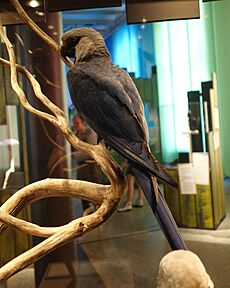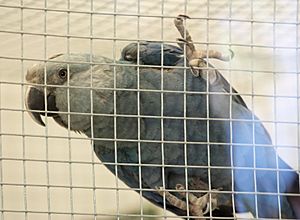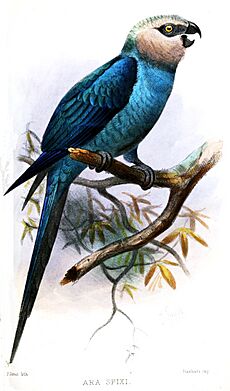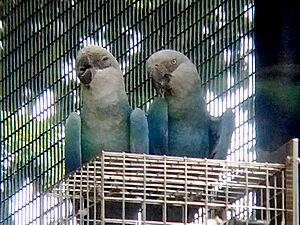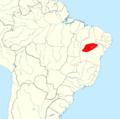Spix's macaw facts for kids
Quick facts for kids Spix's macaw |
|
|---|---|
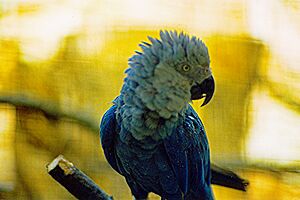 |
|
| An adult Spix's macaw in Germany in 1980 | |
| Conservation status | |
| Scientific classification | |
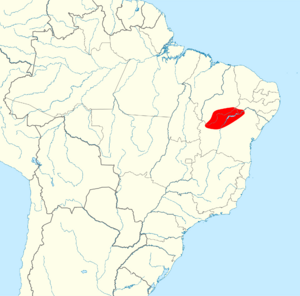 |
|
| Synonyms | |
|
List
|
The Spix's macaw (Cyanopsitta spixii), also called the little blue macaw, is a beautiful blue parrot. It used to live only in Brazil. This bird is a type of macaw, which are large, colorful parrots.
A German scientist named Georg Marcgrave first described this bird in 1638. Later, another German scientist, Johann Baptist von Spix, found a specimen in 1819. The bird is named after him.
Sadly, the Spix's macaw completely disappeared from its natural home. In 2019, experts officially said it was extinct in the wild. This means there were no more left living freely.
But there's good news! After more than 20 years of hard work, over 200 macaws have been bred in special programs. In June 2022, 52 of these birds were released back into their natural environment.
This macaw is a medium-sized parrot. It weighs about 300 grams (10.6 ounces). It is smaller than most other large macaws. Its feathers are different shades of blue. Its head is grey-blue, its belly is light blue, and its back and wings are a bright, vivid blue. Male and female Spix's macaws look almost the same. However, females are usually a little smaller.
The Spix's macaw lived in special forests along rivers in Brazil. These forests had a tree called Caraibeira. The macaws depended on these trees for nesting, eating, and sleeping. They mainly ate seeds and nuts from Caraibeira trees and other plants. Because their forest home was cut down, the bird became very rare.
The Spix's macaw is listed under CITES Appendix I. This means it is against the law to trade them internationally. This is done to protect them. The IUCN officially says the Spix's macaw is extinct in the wild. The last wild bird was seen in 2000, and then possibly again in 2016.
Today, the species is being saved through a special breeding program. Several groups are working together with the Brazilian government. They are bringing birds back to Brazil to release them. The goal is to bring the Spix's macaw back to its wild home.
Contents
Understanding the Spix's Macaw
What is a Spix's Macaw?
The Spix's macaw is the only species in its group, called Cyanopsitta. The name Cyanopsitta comes from ancient Greek words meaning "blue" and "parrot." So, it means "blue parrot." The second part of its name, spixii, is a Latin way of honoring Johann von Spix.
This macaw is one of six types of macaws from Central and South America. These macaws are known for their long tails. Scientists have studied the Spix's macaw. They found it is somewhere between the large macaws and smaller parrots.
How the Spix's Macaw Got Its Name
In 1638, a European scientist named Georg Marcgrave saw and described this bird first. But it was named after Johann Baptist von Spix. He collected the first official sample of the bird in 1819.
At first, Spix thought it was a different macaw. But in 1832, another German scientist, Johann Georg Wagler, realized it was a new species. He named it "Sittace spixii." Later, in 1854, Prince Charles Lucien Bonaparte gave it its own special group, Cyanopsitta. This was because it looked different from other blue macaws.
Appearance of the Spix's Macaw
It's easy to spot a Spix's macaw because it's the only small blue macaw. It also has grey skin around its eyes and beak. The bird is about 56 centimeters (22 inches) long. This includes its long tail.
Male and female Spix's macaws look the same on the outside. However, males are usually a bit heavier. They weigh about 318 grams (11.2 ounces). Females weigh about 288 grams (10.2 ounces).
Their feathers are grey-blue on the head. They are light blue on the belly. The back, wings, and tail are a bright, vivid blue. Their legs and feet are brownish-black. Adult birds have grey skin on their face. Their beak is dark grey, and their eyes are yellow.
Young Spix's macaws look like adults. But their face skin is pale grey. Their eyes are brown. They also have a white stripe along the top of their beak.
Spix's Macaw Behavior
What Spix's Macaws Eat
In the wild, Spix's macaws mostly ate seeds and nuts from two plants: Pinhão and Favela. However, these plants were not originally from the macaw's home. So, they probably ate other things before these plants arrived.
Their diet also included seeds and nuts from many other trees and shrubs. These included Joazeiro, Baraúna, Imburana, Facheiro, and Caraibeira. They also ate from Angico, Umbu, and Unha-de-gato.
Reproduction and Life Cycle
Spix's macaws bred in captivity become ready to have babies at seven years old. In the wild, they have special ways of finding a mate. They might feed each other or fly together. This can take a few years for other large parrots, and it might be the same for Spix's macaws.
They build their nests inside hollows of large Caraibeira trees. They use the same nest year after year. The breeding season is from November to March. Most eggs hatch in January. This is when the rainy season starts in their home area.
In the wild, Spix's macaws were thought to lay three eggs at a time. In captivity, they lay about four eggs, but it can be anywhere from one to seven. The mother bird sits on the eggs for 25 to 28 days. Only the female does the egg sitting. The baby birds leave the nest after about 70 days. They become fully independent in 100 to 130 days.
The Spix's macaw makes a sound like "whichaka" to call its mate. It also makes short, rough noises and squawks.
We don't know how long they live in the wild. The last wild male lived for more than 20 years. The oldest bird in captivity lived to be 34 years old.
Where Spix's Macaws Lived
The Spix's macaw was last known to live in the Rio São Francisco valley in northeastern Brazil. This was mainly in the State of Bahia. Some scientists thought they might have lived in other areas too.
However, studies of the last wild bird found in 1990 showed something important. The Spix's macaw was very special. It only lived in certain "woodland galleries." These were narrow strips of forest along seasonal waterways. These forests were made up of Caraibeira trees. If these trees were cut down, the macaws disappeared.
Much of the bird's original home was destroyed before scientists could study it. It is now believed they lived in a narrow area along the Rio São Francisco. This area was about 50 kilometers (31 miles) wide and 150-200 kilometers (93-124 miles) long.
The Caatinga region where they lived is hot and dry. It has small trees, thorny bushes, and cacti. The Spix's macaw lived in the Caraibeira tree forests within this area. These Caraibeira forests created a cooler, wetter place for the birds. The large, old Caraibeira trees provided nesting holes. They also gave shelter and food (their seedpods) to the macaws.
History of the Spix's Macaw
The Spix's macaw was first described by Georg Marcgrave in 1638. He saw them in Pernambuco, Brazil. He wrote that they were "ashy-bluish" and loved fruit.
Johann Baptist von Spix collected the first sample in 1819 near the São Francisco River. He noted that they lived in flocks but were very rare.
After that, the bird was not seen for 84 years. In 1903, Othmar Reiser saw one. This led to the idea that the bird lived in a very large area.
In 1967, Brazil made a law to protect its wildlife. In 1975, Brazil joined the CITES treaty. These actions made it harder to trade birds illegally. But it also made it harder to track the Spix's macaws that people owned.
Scientists did not study the bird in the wild until the 1970s. In 1974, Helmut Sick saw groups of three and four birds. But by the early 1980s, many Spix's macaws were taken from the wild by traders. People thought they were extinct in the wild.
From 1985 to 1988, Dr. Paul Roth studied the birds. He found only five birds in 1985, three in 1986, and only two after May 1987. Two of these birds were captured in 1987.
In 1990, only one male bird was found in the wild. He was paired with a different type of macaw. A female Spix's macaw was released from captivity in 1995. But she died after seven weeks. The last wild male disappeared in October 2000. This was thought to be the end of the species in the wild. However, some wild Spix's macaws might have been seen in 2016.
As of June 2022, a group of eight Spix's macaws has been released back into the wild. They seem to be doing well. Another twelve were released in December of the same year.
Why the Spix's Macaw Disappeared
The Spix's macaw was already rare in 1819. This was after 100 years of burning, logging, and grazing in their home. For centuries, forests were cut down. People moved into their habitat. Farms grew along the Rio São Francisco. This caused a sharp decline in the 20th century.
Experts think that the remaining habitat could only support about 60 birds. Other problems also hurt the macaws. Rats, wild cats, mongooses, and marmoset monkeys ate their eggs and young. Goats, sheep, and cattle destroyed young Caraibeira trees.
Changes on the north side of the São Francisco River also hurt them. Forests were turned into farms. A dam built in 1974 flooded their forest homes. This pushed the macaws out of their original area.
The main reasons for their decline in the 1970s and 80s were:
- Hunting and trapping the birds.
- Cutting down Caraibeira trees for firewood.
- The Sobradinho Dam, which flooded their forest.
- Africanized bees, which competed for nesting spots.
Caraibeira trees grow very slowly. Most are 200-300 years old. There has been no new growth for 50 years. Also, 45% of their dry forest home has been cleared for farms. Climate change is also turning parts of their home into desert. This means less habitat for the birds.
In 2019, the IUCN officially said the species was extinct in the wild.
Saving the Spix's Macaw
In the mid-1980s, it became clear that the Spix's macaw was almost gone from the wild. Conservationists realized they needed a breeding program. In 1987, only 17 Spix's macaws could be found in captivity.
In 1990, the Brazilian government started a project called Ararinha Azul (Little Blue Macaw project). Its goal was to save the species. At that time, there were only 15 known captive birds and one in the wild. This was a very low point for the Spix's macaw.
Since 1987, the Loro Parque Foundation has helped protect the last wild male. They also worked to protect and restore the bird's habitat. In 1997, they gave ownership of their Spix's macaws to the Brazilian government.
Between 2000 and 2003, many Spix's macaws were bought by Sheikh Saud bin Muhammed Al Thani of Qatar. He created the Al Wabra Wildlife Preservation. This place set high standards for caring for the birds.
In 2007 and 2008, two farms in Brazil were bought by conservation groups. These farms are an important part of the Spix's macaw's natural home. Efforts are ongoing to remove harmful animals and restore the Caraibeira trees.
In 2012, the Brazilian government made a plan to bring the species back to the wild. The plan included:
- Increasing the captive population to 150 birds by 2020.
- Building a breeding center in Brazil.
- Buying and restoring more of their habitat.
- Preparing to release them into the wild between 2017 and 2021.
A special aviary called NEST was built in Brazil. Birds from other places were moved there. The Spix's macaws at NEST are owned by the Brazilian government.
Spix's Macaws in Breeding Programs
The Spix's macaws in breeding programs today all came from just 7 original wild birds. These birds were closely related. This has caused some problems, like birds not being able to have babies easily.
As of 2022, there are about 177 Spix's macaws in captivity. Many of these are part of an international breeding program. This program is managed by the Brazilian government. Most of these birds are at Al Wabra Wildlife Preservation (AWWP). Other birds are at Loro Parque Foundation, ACTP in Germany, NEST in Brazil, and Pairi Daiza in Belgium. These groups are working hard to bring the Spix's macaw back to its natural home.
| Institutions / Locations | Males | Females | Unknown | Total | Bred in captivity |
|---|---|---|---|---|---|
| Al Wabra Wildlife Preservation (AWWP), Doha, Qatar | 24 | 36 | 4 | 64 | 37 |
| Association for the Conservation of Threatened Parrots (ACTP), Berlin, Germany | 4 | 3 | 0 | 7 | 5 |
| Loro Parque Foundation (LPF), Tenerife, Canary Islands, Spain | 0 | 1 | 0 | 1 | 6 |
| NEST, Avaré, Brazil | 3 | 7 | 2 | 12 | 2 |
| (private owners), Switzerland | ? | ? | ~13 | ~13 | ~8 |
| Pairi Daiza, Brugelette, Belgium | ? | ? | 18 | 18 | ? |
| Total | 31 | 47 | ~37 | ~115 | ~58 |
Note: table data based on "Al Wabra ICMBio data from June 2013" and Watson, R. (Studbook Keeper) 2011. "Annual Report and Recommendations for 2011: Spix’s Macaw (Cyanopsitta spixii)".
Health and Breeding Challenges
The captive Spix's macaw population has very low genetic diversity. This means the birds are closely related. This can lead to problems like eggs not being fertile or baby birds dying. For example, at AWWP, only one out of six eggs is fertile. And only two-thirds of those hatch.
For a while, captive birds seemed to become ready to breed later than expected. The youngest pairs to lay fertile eggs were 10 years old. Another problem is that more female chicks are born than male chicks.
Almost all baby birds in the program are raised by experienced staff. This helps make sure the rare chicks survive. Scientists use DNA tests on feathers to find out if a chick is male or female.
Spix's macaws choose their own mates. This means the best genetic pairs might not always happen. Sometimes, birds that look like a pair are not actually mates. This can take a few seasons to figure out. Also, sick birds cannot be paired with healthy birds. This is to stop diseases from spreading.
New Breeding Methods
Scientists are using new methods to help the Spix's macaw reproduce. In 2009-2010, researchers developed a new way to collect semen from large parrots.
In 2012, scientists used artificial insemination for the first time with Spix's macaws. This means they helped the birds reproduce without natural mating. In 2013, this led to the world's first Spix's macaw eggs and chicks from assisted reproduction. Two chicks were born. The first chick was named "Neumann."
Bringing Them Back to the Wild
In 2018, there were about 158 Spix's macaws in the world. An agreement was made to bring 50 of them back to Brazil by early 2019. The Spix's macaw was finally released into the wild in June and December of 2022.
The project to reintroduce the Spix's macaw in Brazil includes:
- Creating two protected areas in Bahia, Brazil.
- Working with local people to raise awareness.
- Building a center for breeding and helping birds get used to the wild again.
In August 2018, most of the world's Spix's macaws (146 out of 160) lived at a conservation group in Germany. Many of these birds came from Qatar. The goal of this group is to produce about 20 macaws each year.
Born in the Wild Again!
Between April and July 2021, three Spix's macaws were born in the wild in Brazil! This was 20 years after they were declared extinct in the wild. The chicks came from a pair that had been brought from Germany in 2020. The Brazilian government agency, ICMBio, said the species would be reintroduced into nature in the coming years.
In late October 2023, two more Spix's macaws were confirmed to be born in the wild. These chicks came from a pair that had been released from captivity in June and December 2022. This is great news for the future of the Spix's macaw!
Spix's Macaws as Pets

The Spix's macaw was very rare to see in public zoos. In 1900, the Berlin Zoo showed "the four blues." This included the Spix's macaw, glaucous macaw, hyacinth macaw, and Lear's macaw.
Only a few wealthy collectors owned Spix's macaws. The first known ones were three birds at the London Zoological Society between 1878 and 1902.
One person who owned a Spix's macaw in 1900 said it was "more like a Conure" (a smaller parrot). He said his bird wouldn't eat soft foods. It mainly ate sunflower seeds. He also said it would bark the branches of its tree.
The first time a Spix's macaw was successfully bred in captivity was in the 1950s in Brazil. A man named Alvaro Carvalhaes hatched many chicks. Some reports say he hatched as many as 24. Most of his birds died in the 1970s.
In October 2002, a Spix's macaw named Presley was found in Colorado, USA. He was sent back to Brazil. This bird was not known to be alive in 1987. Presley died in June 2014, at about 40 years old.
Today, all known Spix's macaws are part of the conservation program run by the Brazilian government. This means you cannot get a Spix's macaw as a pet anymore.
Possible Rediscovery
On June 18, 2016, one Spix's macaw was seen in Curaçá, Brazil. The next day, a video of the bird was taken. Its call was identified as a Spix's macaw. However, some experts think this bird might have been one that was released from captivity.
Images for kids



